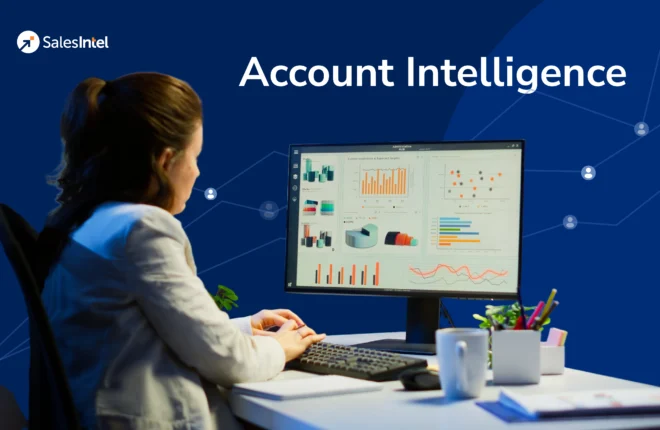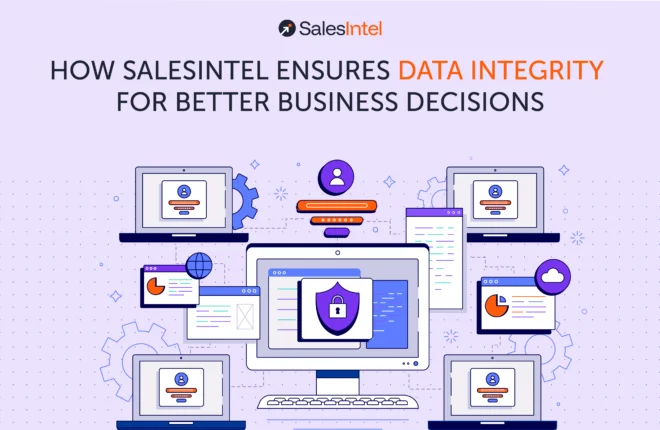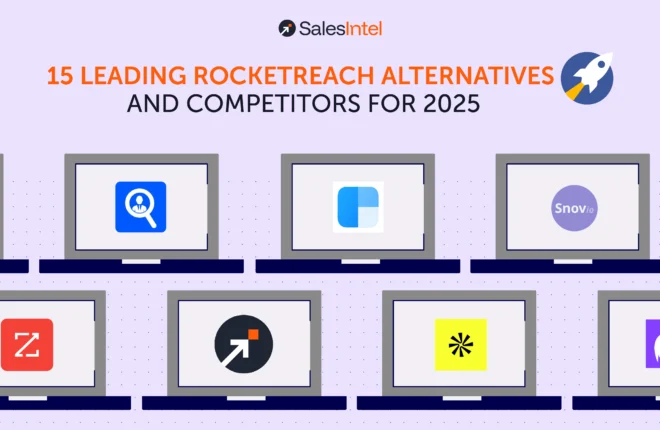Picture this. You are the sales team lead for a SaaS product being launched in a highly competitive market. How do you appeal to ideal prospects to choose your product over those from established competitors? The answer is simple—be more intelligent in targeting them.
This is where account intelligence comes into play.
Buyers today, especially in B2B markets, are well-informed about their options, which puts them in the driver’s seat of a sales cycle. So, what can companies do to establish themselves top of mind and turn prospects into customers?
Businesses can use data about the company and its decision-makers to understand the unique needs and preferences of each account and leverage those insights to craft targeted strategies and tailored messaging that build trust and lead to stronger relationships. This data is referred to as account intelligence. Account intelligence data can be critical to gaining a competitive advantage and closing more deals, in today’s increasingly crowded markets.
In this blog, we will provide you with a complete overview of account intelligence, including what it means, why it is important to gather account intelligence data today, the key components of account intelligence data, and how you can leverage account intelligence data to close more sales and revenue for your organization.
What is Account Intelligence?
Account intelligence is the collection of B2B first-party and third-party data about target accounts that can be analyzed, interpreted, and converted into insights that help your marketing and sales teams better understand leads and accounts. This enables them to craft personalized sales pitches and turn promising prospects into paying customers.
Clear and reliable account intelligence data can, in fact, assist your entire GTM team in understanding your target audiences’ characteristic traits, buying intentions, preferred products and services, and even when they are most likely to make a purchase. This can help you align your business goals with your key accounts’ desired outcomes, thereby fostering stronger relationships, identifying new opportunities, improving customer satisfaction, and driving growth and long-term success. Now, isn’t that the dream?
Here is a breakdown of the key aspects of account intelligence:
- Accurate and reliable data: Account intelligence relies on collecting data from various sources, including market research, CRM systems, website analytics, and other third-party data sources. This data should include firmographic details (company size, revenue, and industry), technographic (tools and technologies used), and behavioral data (engagement history). Businesses can better understand their accounts and tailor strategies effectively by leveraging reliable data.
- Data ONLY pertains to target accounts: The focus is on deep insights into specific, high-value accounts rather than a broad audience. Understanding each account’s unique needs, challenges, and preferences enables a personalized approach, improving the chances of conversion and fostering long-term relationships.
- Actionable Insights: Account intelligence must go beyond raw data. The information should be parsed, analyzed, and interpreted to provide valuable insights that drive action. For example, recognizing a prospect’s recent expansion can prompt an offer tailored to scaling solutions, ensuring GTM efforts align with real-time opportunities.
- Improved Decision-Making: The purpose of obtaining account intelligence must center on assisting teams in making informed decisions about where to allocate resources, which opportunities to prioritize, and how to approach each account. This reduces guesswork and ensures every strategy is backed by relevant information.
Benefits of Account Intelligence Data
Understanding an account’s history, challenges, and decision-makers allows companies to stay ahead, adapt strategies proactively, and win more deals. However, these are not the only benefits of account intelligence data.
Here is why collecting account intelligence data is important:
Enhanced Customer Engagement
Account intelligence enables businesses to understand the unique needs, preferences, and challenges of their target accounts. This helps marketing and sales teams craft highly personalized campaigns that resonate with prospects, increasing customer engagement.
Better Resource Allocation
With account intelligence, businesses can identify high-value accounts most likely to convert. This allows teams to focus their time, energy, and resources on opportunities that matter, optimizing efficiency and driving better returns on investment.
Improved Customer Relationships
Detailed knowledge about accounts fosters meaningful interactions. Understanding client pain points and goals helps businesses deliver tailored solutions, resulting in stronger relationships, higher satisfaction, and greater loyalty over time.
Predictive Insights for Sales Forecasting
Predictive insights, powered by account intelligence, can be very useful for sales forecasting. These can help prioritize high-potential leads, anticipate churn risks, and align marketing and sales efforts. Businesses can make proactive, data-driven decisions by identifying trends and future needs, thereby improving efficiency, driving conversions, and staying ahead of competitors while fostering stronger, long-term customer relationships.
Aligned Marketing and Sales Strategies
Account intelligence data can help marketers and salespeople align to create campaigns that resonate deeply with target accounts. Knowing specific details, such as a target account’s pain points, buying patterns, and decision-making criteria, enables these teams to craft account-based marketing or ABM campaigns that address particular pain points. This ensures alignment between marketing and sales, resulting in more impactful outreach.
Key Components of Account Intelligence Data
Four main types of data combine together to provide account intelligence. These include:
Firmographic Data
Firmographic data includes key information about a business, such as its industry, company size, revenue, location, and number of employees. Firmographic data is static and hence can be easily obtained.
For example, a software company might target businesses in the healthcare sector with annual revenues exceeding $10 million, headquartered in urban areas, and employing over 200 staff members. Other firmographic details could include business structure (e.g., private or public) and growth stage (e.g., startup or enterprise).
Technographic Data
Technographic data refers to information about the technologies and tools a company uses. This data typically offers limited insights but can be useful when combined with firmographic and contextual data (discussed below).
Examples include the CRM software they rely on, their choice of email marketing platforms, cloud storage providers, cybersecurity solutions, and web hosting services. For instance, knowing a prospect uses Salesforce as their CRM or AWS for cloud computing can help tailor your pitch to align with their existing tech stack and needs.
Behavioral Data
Behavioral data refers to information on prospects’ interactions with your brand.
This dynamic data can tell which accounts are interested in your company’s offerings, thus qualifying prospects that are most likely to convert.
Examples include website visits, pages viewed, time spent on specific pages, and actions like downloading resources or filling out forms. Behavioral data also includes email engagement metrics, such as open rates, click-through rates, and replies. Besides these, tracking social media interactions, webinar attendance, and product usage patterns can also provide valuable behavioral insights to shape successful outreach campaigns.
Contextual Data
Contextual data includes information that provides deeper insights into a target account’s current situation, such as how accounts are using their current technology, how much money they have set aside for it, and other details like agreements with competing vendors.
This type of information is extremely valuable because it is product-specific and tells you if the prospects you are targeting need your solution or not.
Examples include a company’s recent funding announcements, mergers or acquisitions, changes in leadership, and expansion into new markets. It can also encompass industry trends, buying patterns, and competitor analysis. For individual prospects, contextual data includes job changes, professional milestones, or recent interactions with your business.
Compiling the four components of account-based intelligence contributes to developing a more comprehensive image of a target account, which can better inform ABM initiatives. While firmographics and technographics are primarily third-party data, behavioral and contextual data can only be gathered from first-party sources.
How Can Marketing and Sales Teams Leverage Account Intelligence?
Account intelligence can enable marketers and salespeople to create aligned initiatives that drive mutual team success which, in turn, can help an organization generate more sales and revenue. Here is a roadmap to establish a strong foundation for account intelligence:
Define Goals and Objectives
To effectively use account intelligence, teams must first establish clear goals and objectives. This could include increasing lead conversion rates, improving customer retention, or identifying high-value accounts for targeted campaigns. Such measurable outcomes can help both marketing and sales teams align their efforts with specific business objectives, ensuring all account intelligence activities serve a strategic purpose.
Conduct Prospective Customer Research
Researching prospective customers is crucial for building a strong foundation of account intelligence. Learning more about your ideal customer accounts can help you —
- Identify high value opportunities (typically those with a large budget or an urgent need for your products)
- Gain deeper insights into a company’s size, industry, revenue, challenges, technology stack, and leadership
- Qualify accounts to weed out unserious buyers and save time your sales reps might otherwise waste on them
- Customize outreach messages to speak to the prospects’ needs and pain points
This research provides insights into the needs and pain points of target accounts, enabling personalized communication that resonates with prospective customers.
Collect, Clean, and Organize Data
Accurate and organized data is the backbone of account intelligence. Teams should collect data from reliable sources such as CRM platforms, social media, and third-party tools. Regular data cleaning—removing duplicates, outdated entries, and inaccuracies—ensures the information remains relevant. Following data cleaning, teams must organize data into standardized and accessible formats to help streamline analysis and decision-making.
Analyze Trends and Insights
Once the data is collected and organized, it is time to analyze it for actionable insights. Identifying trends such as purchasing behaviors, common challenges, or market demands helps teams understand what drives their target accounts. These insights can also highlight opportunities for cross-selling, upselling, or breaking into new markets, ensuring both marketing and sales efforts are focused on high-impact areas.
Turn Data into Actionable Strategies
Insights from account intelligence insights should be translated into concrete actions. For marketing teams, this could mean creating personalized content, targeted email campaigns, or industry-specific ads. Sales teams can use the insights to tailor pitches, address specific pain points, and provide solutions that align with the customer’s goals. Taking action ensures the data moves from analysis to producing tangible results for your business.
Promote Data-Driven Decisions
Account intelligence empowers teams to make informed decisions rather than relying on guesswork. Integrating these insights into marketing and sales processes can help you train these teams to foster a culture for data-backed understanding. For example, understanding which accounts are more likely to convert allows teams to prioritize resources effectively. Data-driven decisions also reduce the risk of targeting the wrong accounts or investing in ineffective strategies, improving overall efficiency and ROI.
Monitor and Refine the Program
Leveraging account intelligence is an ongoing process. Marketing and sales teams should continuously monitor the effectiveness of their initiatives by tracking metrics like engagement rates, conversion rates, and customer feedback. Regularly refining strategies based on these insights ensures continuous improvement, helping teams adapt to changes in customer needs or market conditions. Continuously updating the program based on performance and market insights and trends can deliver desired outcomes.
Tools for Collecting Account Intelligence Data
There are multiple software options available that you can use to gather account intelligence data. Here is an overview of the most essential tools for gathering account intelligence data:
Customer Relationship Management (CRM) Platforms
CRMs like Salesforce or HubSpot store and manage customer and account data, track interactions, and provide a centralized platform for sales and marketing teams to access real-time insights. CRM data includes prospect contact information, orders with your organization, performance metrics for your ABM campaigns, and sales opportunities data.
Data Enrichment Platforms
These are tools that help enhance account profiles by adding missing information like company size, revenue, or decision-maker details, ensuring a more comprehensive understanding of target accounts. Such software helps unearth both firmographic and contextual data, such as information about prospects’ intent.
One great example of a data enrichment platform is SalesIntel. This software provides account intelligence that helps your GTM team streamline multiple aspects of their strategy—from market research to competitie analysis, lead generation, and sales outreach. SalesIntel even offers company technographics and partners with the behavioral data platform, Bombora, to help marketing and sales teams dive deep into prospects’ behaviors to pinpoint the exact time you should reach out to them. SalesIntel also comes with sales engagement and data cleaning capabilities. It is an all-in-one platform for GTM teams to collect and leverage account intelligence and build data-driven strategies for sales success.
Predictive Analytics Tools
Predictive analytics tools like Tableau and Power BI leverage historical data and artificial intelligence to identify high-value prospect accounts by analyzing patterns like purchasing histories, engagement rates, and past conversions. They can also predict churn risks or cross-selling opportunities, enabling teams to take proactive measures.
Social listening tools like Hootsuite or Sprout Social monitor conversations across social media for mentions of target accounts, competitors, or industry trends. These tools provide insights into customer sentiment and pain points that can guide personalized outreach. For example, a spike in negative sentiment around a competitor’s product can inform timely outreach efforts that incite those disgruntled customers to jump ship to your brand.
Business Intelligence Software
Business intelligence software like Domo or Looker aggregate data from multiple sources into a unified platform that helps marketing and sales teams visualize the data in the form of actionable dashboards and reports. Teams can track performance metrics like engagement rates, revenue trends, or campaign effectiveness in real time using these tools. BI software also supports deeper analysis, such as identifying bottlenecks in the sales process or areas where marketing strategies need refinement, ensuring that decisions are backed by comprehensive and up-to-date data.
Conclusion
Account intelligence data can be a game-changer in highly competitive business environment because it helps companies understand the human psychology driving account behaviors and purchase decisions. However, not all data is created equal.
There is a hierarchy of data types. For example, firmographic data helps identify potential target accounts, but not much else. Technographic data and behavioral data, on the oter hand, can help you decipher what technologies your target account is using and whether they are looking to make a move to a different product, which in this case, could be yours, if you personalize your outreach just right and retarget your campaigns to the relevant customers. The more dynamic your data, the greater your chances of conversion.
Want to convert more prospect accounts into paying customers? Leverage account intelligence data with SalesIntel. Book a demo to learn more today.




